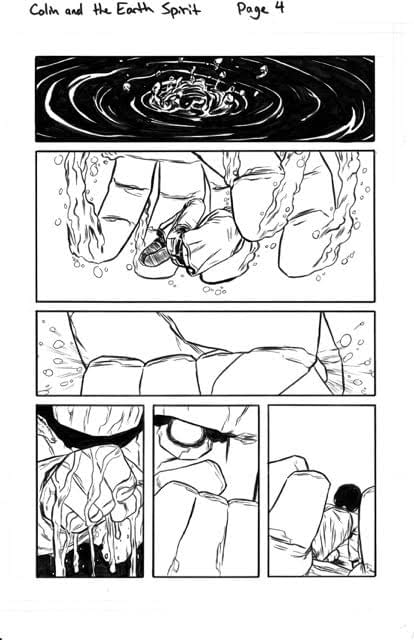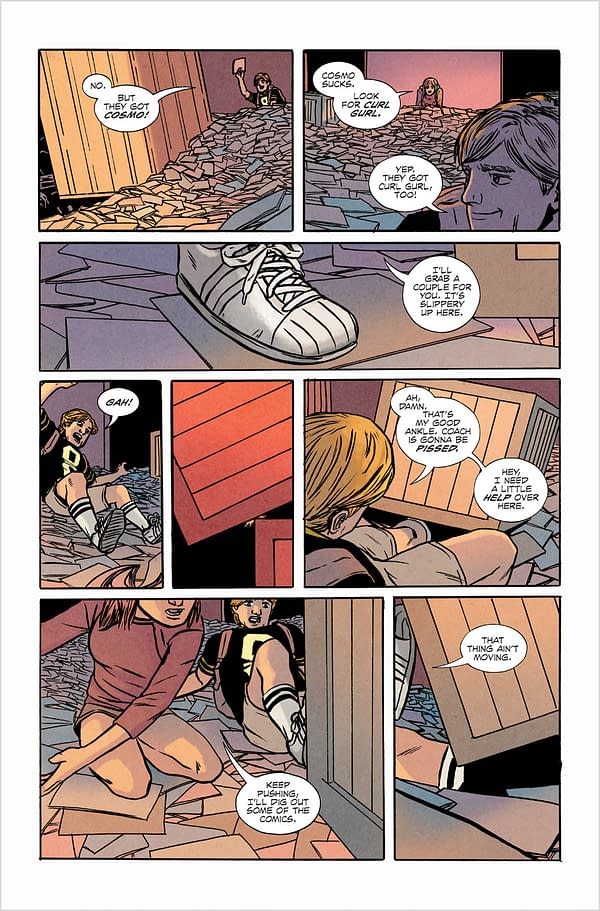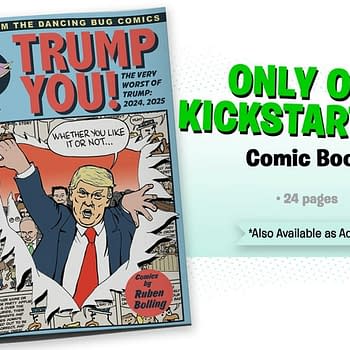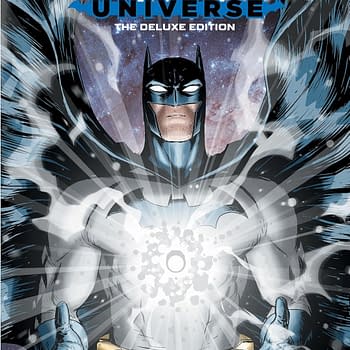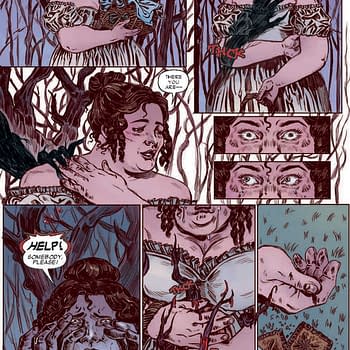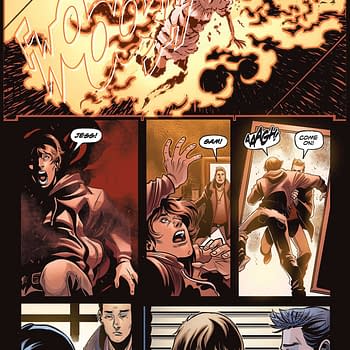Posted in: Comics, Recent Updates | Tagged: comic con, Comics, entertainment, san diego, san diego comic con, sdcc, sdcc2016
Breaking Into Comics, A Case Study By Kody Chamberlain
Kody Chamberlain writes,
"Gavin's got a great future ahead of him. His work is rock-solid and he's already got the confident storytelling of an industry veteran. And the fact that he's another Louisiana native makes me like him even more." —Rob Guillory
One of the most popular subjects discussed at conventions is BREAKING IN. Aspiring professionals are always looking for tips and tricks to get a foot in the door, panels are packed with hungry creators looking for a shot, and portfolio review lines will often wrap around the building. Those of us that found our way in are more than happy to share our own stories about breaking in. Still, when a new project comes along, it can be surprisingly difficult to find an artist when you need one.
It's an amazing paradox.
As I prepared my schedule for the 2015 San Diego Comic Con, I had two projects in mind but had set the goal of finding the right artist for one project in particular. I had it all worked out in my mind: A systematic walk through the ever-shrinking rows of Artist Alley, then the Small Press section, and throughout I'd check in with just about every creator I know for solid referrals until I found that perfect someone that matched the stylistic range I had in mind. Then I'd take on the bigger challenge of trying to talk them into drawing the book.
To prepare for the trip, I put out a simple call for artists on Twitter.
I got a few retweets/comments and it seemed like things were starting to line up. As I exchanged emails for potential meetings and fielded a few questions, it happened. An artist grabbed the project before anyone else even had a shot.
Gavin's approach is a great case study in how to land a comic project and could be broken down into three simple steps.
Step 1. Actively hunt for opportunities.
Step 2. Apply the right approach to landing an opportunity.
Step 3. Be fully prepared for the opportunity when it comes.
Let's take them one at a time.
Step 1. Hunting for projects starts with being active in the comic book community by establishing and maintaining connections with creators, publishers, and editors. Follow them on social media, get on their newsletters, chat with them at conventions. You can't simply add pros to a mailing list to constantly shout updates about your work, you also have to listen. Read what they're sharing and understand their approach to the business, jump on news sites like this one, and listen to quality podcasts. More importantly, look for hints for upcoming projects they're working behind the scenes, learn to read between the lines.
My goal early on was to focus on crime and horror comics so I payed particular attention to the publishers that were friendly to that kind of work, and the crime and horror creators that were doing the kinds of projects I wanted to do. I also made sure to get to know the editors that helped bring those projects to life. My opportunity to break in came when writer Steve Niles needed an artist for 30 Days of Night. The opportunity to draw that book wasn't a result of dumb luck, I had been working hard to make myself known to IDW, Steve Niles, and then editor Jeff Mariotte. Before that opportunity, I had a few dozen shots that just didn't work out. It's a numbers game. The hunt requires more than an outgoing email list, it requires preparation, patience, research, and hustle. Great opportunities rarely make it to the classifieds. If you're searching the job sites, you're already too late. Timing is everything. That brings me to…
Step 2. Your approach can sometimes hurt your chances for landing that first project. Gavin didn't bombard me with info, artwork, questions, or requests for all the details. He simply replied with the mention of "local" and included a short question asking about my intentions. That got me fully engaged in a Direct Message conversation on Twitter. An overload of questions, requests for details, material, etc. would have been a warning sign. The other extreme is also true. Not enough dialog might be read as a lack of interest or passion. A simple link to sample pages may not have had the same result. With an active and professional query, a dialog was opened. Gavin didn't ask me to help solve his problem of breaking in, he offered to solve my problem of finding an artist. A simple distinction, but a powerful one.
Just like a job interview, what you say and how you say it both have an impact. A collaboration requires interaction, and no one wants to work with a high-maintenance person. You've got to prove you can handle the communication side of the equation as early as possible, and a big part of that communication is understanding what's important and what isn't. Rather than overload me with sample work, Gavin sent me less than seven pages based on what he thought fit the genre I described in our short Twitter conversation. Just like the initial conversation, he didn't overload me, he pulled the absolute best work he had to offer, and that's what he showed. He also made another bold decision. He sent me inked pages without coloring or lettering. The artwork would have to stand on its own merits, and it did. I've included those sample pages here (artwork by Gavin Guidry based on a story by Steven Menszer).
Obviously "local" was another big win. A local artist is actually preferable. In fact, studio mate Rob Guillory was originally going to draw the book (he did the main character designs, and is now doing covers). I was chatting with my good pal Burt Durand about drawing the book as well. Local isn't just acceptable, it's preferable. Be sure to stay in tune with who's doing great work in your area. It's often the smartest and simplest way to find new project opportunities.
Step 3. The most important thing of all. When I sent Gavin the story for the 6 sample pages needed for the pitch, he did the pages quickly and the work was superb. He had been working toward building the capacity to handle the project long before opportunity knocked. Had the pitch pages come in very late or at a lesser quality than the samples he showed, I would have certainly continued my search elsewhere. I've included the pitch pages below. (Pencils and inks by Gavin Guidry, colors by K. Michael Russell.)
"You're gonna need a bigger boat." — Brody in JAWS.
Trust me, the shark is bigger than you think. You've got to build up the capacity for that opportunity before it happens, not after. I recall standing in a portfolio line many years ago trying to get an editor at Dark Horse to look at my sample pages. The guy in front of me was showing off his pages to everyone and we were all blown away. If anyone in this line got offered work, it'd most certainly be him. On a whim, I asked how long he took to draw those pages, and he proudly said he worked on each page for about three months. Anyone that's ever gone near a comic book knows that three months per page is not an acceptable pace for anyone that isn't Travis Charest.
At the time, I hadn't yet been published, but I knew all along I needed to have the capacity to do pages fast enough to handle an opportunity if/when it came along. Capacity is probably the single most neglected aspect of breaking into comics. Neither of us got offered work that day, but if we had, I imagine I would have been the only one to keep the job.
If I had to boil all this down I'd say the real objectives are to build deep connections to find opportunities others might overlook, find ways to offer help rather than ask for it, and build up your capacity for the type of work you'd love to do.
As for the project in question, Gavin and I just launched SMUT AND JEFF on Kickstarter and we'll be doing regular progress updates with sketches, script samples, etc. I'd be thrilled if you gave it a look, and if the opportunity presents itself, please share the links with those you think might enjoy this book. If you have questions about this post or about the SMUT AND JEFF comic, you can find me online at Twitter, Facebook, and Kickstarter.
SMUT AND JEFF — 1982, A typical teenaged boy spending the last week of summer vacation stressed about high school. It's a very familiar feeling of being a boy unprepared for the journey into a man's world. After being mocked and ridiculed, Jeff is determined to steal the one item he's told will transform any boy into a real man: His very first porno magazine.
5 issues, 32 pages each, full color.
Best,
Kody Chamberlain






